Syntax(句法学) %26 Semantics(语义)(第五章,第七章)
- 格式:doc
- 大小:55.50 KB
- 文档页数:7

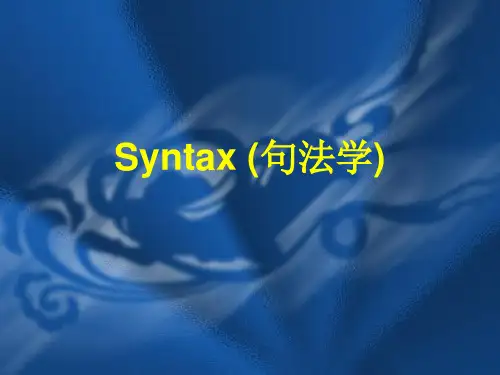
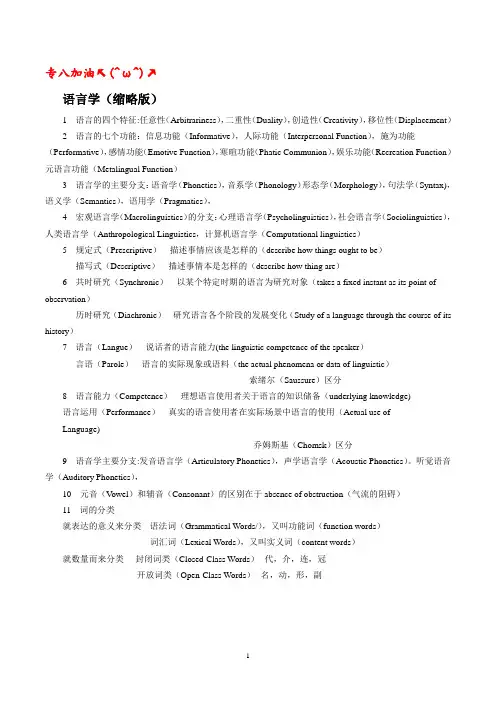
专八加油↖(^ω^)↗语言学(缩略版)1 语言的四个特征:任意性(Arbitrariness),二重性(Duality),创造性(Creativity),移位性(Displacement)2 语言的七个功能:信息功能(Informative),人际功能(Interpersonal Function),施为功能(Performative),感情功能(Emotive Function),寒暄功能(Phatic Communion),娱乐功能(Recreation Function)元语言功能(Metalingual Function)3 语言学的主要分支:语音学(Phonetics),音系学(Phonology)形态学(Morphology),句法学(Syntax),语义学(Semantics),语用学(Pragmatics),4 宏观语言学(Macrolinguistics)的分支:心理语言学(Psycholinguistics),社会语言学(Sociolinguistics),人类语言学(Anthropological Linguistics,计算机语言学(Computational linguistics)5 规定式(Prescriptive)---描述事情应该是怎样的(describe how things ought to be)描写式(Descriptive)---描述事情本是怎样的(describe how thing are)6 共时研究(Synchronic)---以某个特定时期的语言为研究对象(takes a fixed instant as its point of observation)历时研究(Diachronic)---研究语言各个阶段的发展变化(Study of a language through the course of its history)7 语言(Langue)---说话者的语言能力(the linguistic competence of the speaker)言语(Parole)---语言的实际现象或语料(the actual phenomena or data of linguistic)----索绪尔(Saussure)区分8 语言能力(Competence)---理想语言使用者关于语言的知识储备(underlying knowledge)语言运用(Performance)---真实的语言使用者在实际场景中语言的使用(Actual use ofLanguage)----乔姆斯基(Chomsk)区分9 语音学主要分支:发音语言学(Articulatory Phonetics),声学语言学(Acoustic Phonetics)。
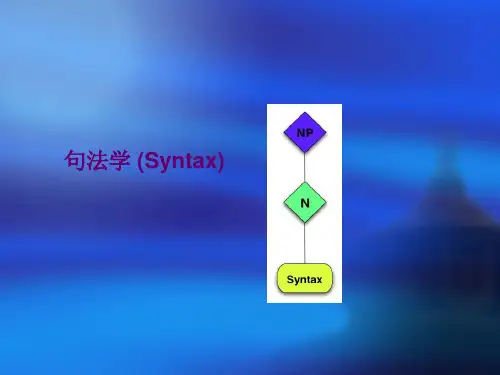
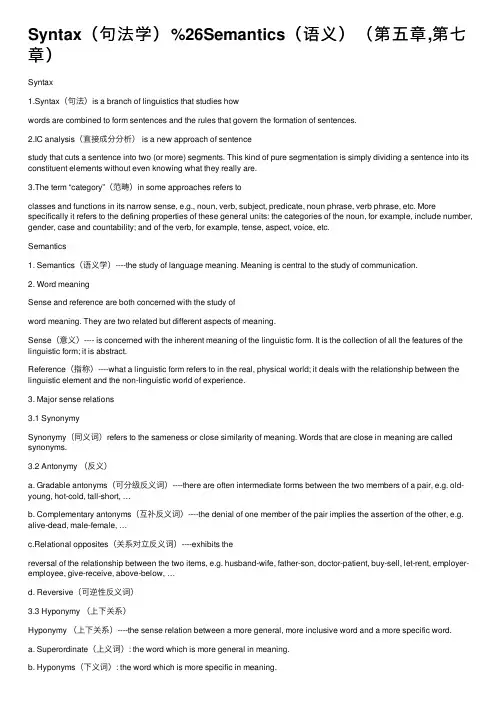
Syntax(句法学)%26Semantics(语义)(第五章,第七章)Syntax1.Syntax(句法)is a branch of linguistics that studies howwords are combined to form sentences and the rules that govern the formation of sentences.2.IC analysis(直接成分分析) is a new approach of sentencestudy that cuts a sentence into two (or more) segments. This kind of pure segmentation is simply dividing a sentence into its constituent elements without even knowing what they really are.3.The term “category”(范畴)in some approaches refers toclasses and functions in its narrow sense, e.g., noun, verb, subject, predicate, noun phrase, verb phrase, etc. More specifically it refers to the defining properties of these general units: the categories of the noun, for example, include number, gender, case and countability; and of the verb, for example, tense, aspect, voice, etc.Semantics1. Semantics(语义学)----the study of language meaning. Meaning is central to the study of communication.2. Word meaningSense and reference are both concerned with the study ofword meaning. They are two related but different aspects of meaning.Sense(意义)---- is concerned with the inherent meaning of the linguistic form. It is the collection of all the features of the linguistic form; it is abstract.Reference(指称)----what a linguistic form refers to in the real, physical world; it deals with the relationship between the linguistic element and the non-linguistic world of experience.3. Major sense relations3.1 SynonymySynonymy(同义词)refers to the sameness or close similarity of meaning. Words that are close in meaning are called synonyms.3.2 Antonymy (反义)a. Gradable antonyms(可分级反义词)----there are often intermediate forms between the two members of a pair, e.g. old-young, hot-cold, tall-short, …b. Complementary antonyms(互补反义词)----the denial of one member of the pair implies the assertion of the other, e.g. alive-dead, male-female, …c.Relational opposites(关系对⽴反义词)----exhibits thereversal of the relationship between the two items, e.g. husband-wife, father-son, doctor-patient, buy-sell, let-rent, employer-employee, give-receive, above-below, …d. Reversive(可逆性反义词)3.3 Hyponymy (上下关系)Hyponymy (上下关系)----the sense relation between a more general, more inclusive word and a more specific word.a. Superordinate(上义词): the word which is more general in meaning.b. Hyponyms(下义词): the word which is more specific in meaning.c. Co-hyponyms(同级下义词): hyponyms of the same superordinate.e.g. Superordinate: furnitureHyponyms: bed, table, desk, dresser, wardrobe, sofa, …3.4 Polysemy (⼀词多义)----the same one word may have more than one meaning.3.5 HomonymyHomonymy---- the phenomenon that words having different meanings have the same form, e.g. different words are identical in sound or spelling, or in both.Homophone(同⾳异义词)---- when two words are identical insound, e.g. rain-reign, night/knight, …Homogragh(同形异义词)---- when two words are identical in spelling, e.g. tear(n.)-tear(v.), lead(n.)-lead(v.), …Complete homonym---- when two words are identical in both sound and spelling4. Componential analysis(成分分析)---- a way to analyze lexical meaning. The approach is based on the belief that the meaning of a word can be dissected into meaning components, called semantic features. For example,Man: [+HUMAN, +ADULT, +ANIMATE, +MALE]Boy: [+HUMAN, -ADULT, +ANIMATE, +MALE]Woman: [+HUMAN, +ADULT, +ANIMATE, -MALE]Girl: [+HUMAN, -ADULT, +ANIMATE, -MALE]Pragmatics语⽤学Pragmatics is the study of how speakers of a language usesentences to effect successful communication.Pragmatics is the study of speaker meaning, contextualmeaning, how more gets communicated than is said.The originSemanticsContext considered Context unconsideredPragmatics Traditional semanticsSentence and utterance话语The relation: Meaning of a sentence is abstract anddecontextualized while meaning of an utterance isconcrete and context-dependent. The meaning of anutterance is based on a sentence meaning and therealization of the abstract meaning of a sentencein a real situation of communication.Example: My bag is heavy. (utterance meaning: a statement,indirec t or polite request, declining someone’s requestfor help)Cooperative Principles and violation of the conversation maxims合作原则和准则的违反The maxim of quantity 数量准则Make your utterance as informative as required. No more and no less.The maxim of quality 质量准则Do not say what you believe to be false and do not saywhat you lack evidence for.The maxim of relation 关系准则Be relevantThe maxim of manner ⽅式准则Avoid obscurity, ambiguity. Be brief and orderly Violation of the maxims and revealing conversation implicature 会话含义The use of the terms principle and maxim does not meanthat the CP and its maxims will be followed by everybody all the time. People do violate them and tell lies. In fact, the significance CP lies in the violations.Examples of the violations of the maxims:1) Violation of the Maxim of QuantityA: What are you readingB: A book.A: Do you know where Dr. Townsend livesB: Somewhere in the southern suburbs of the city. (saidwhen it is known to both A and B that B has Dr. Townsend’s address)2)Violation of the Maxim of QualityA: Would you like to come to our party tonightB: I’m afraid I’m not feeling so well today.(said when it is known to both A and B thatB is feeling perfectly well)3) Violation of the Maxim of RelationA: What time is itB: Well, the paper’s already come.A: The hostess is an awful bore. Don’t you thinkB: The roses in the garden are beautiful, aren’t theyA: What do you think of the lectureB: He’s a good cook.4) Violation of the Maxim of MannerA: Let’s stop and get something to eat.B: Okay, but not M-c-D-o-n-a-l-d-s.A: What did your sister buy at Sears yesterdayB: She bought a red dress, she bought a green dress, and she bought a blue dress.。
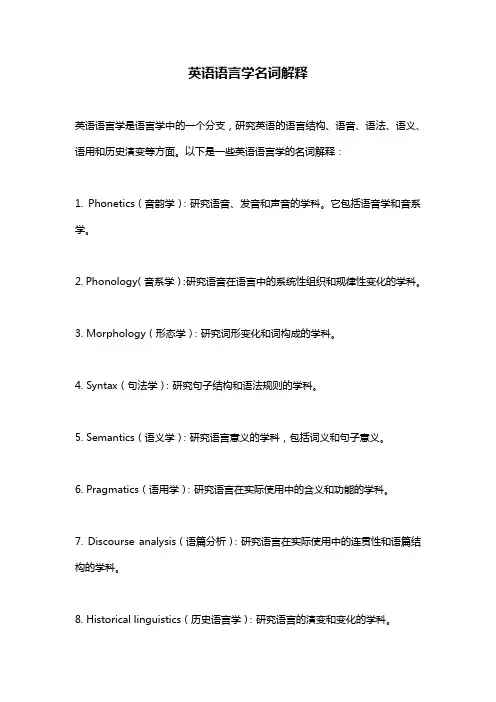
英语语言学名词解释
英语语言学是语言学中的一个分支,研究英语的语言结构、语音、语法、语义、语用和历史演变等方面。
以下是一些英语语言学的名词解释:
1. Phonetics(音韵学):研究语音、发音和声音的学科。
它包括语音学和音系学。
2. Phonology(音系学):研究语音在语言中的系统性组织和规律性变化的学科。
3. Morphology(形态学):研究词形变化和词构成的学科。
4. Syntax(句法学):研究句子结构和语法规则的学科。
5. Semantics(语义学):研究语言意义的学科,包括词义和句子意义。
6. Pragmatics(语用学):研究语言在实际使用中的含义和功能的学科。
7. Discourse analysis(语篇分析):研究语言在实际使用中的连贯性和语篇结构的学科。
8. Historical linguistics(历史语言学):研究语言的演变和变化的学科。
9. Sociolinguistics(社会语言学):研究语言和社会、文化、地理和历史等因素之间的关系的学科。
10. Psycholinguistics(心理语言学):研究语言和心理过程之间的关系的学科,包括语言习得、记忆和理解等。
以上是一些常见的英语语言学名词解释,它们涵盖了英语语言学的主要领域和分支。
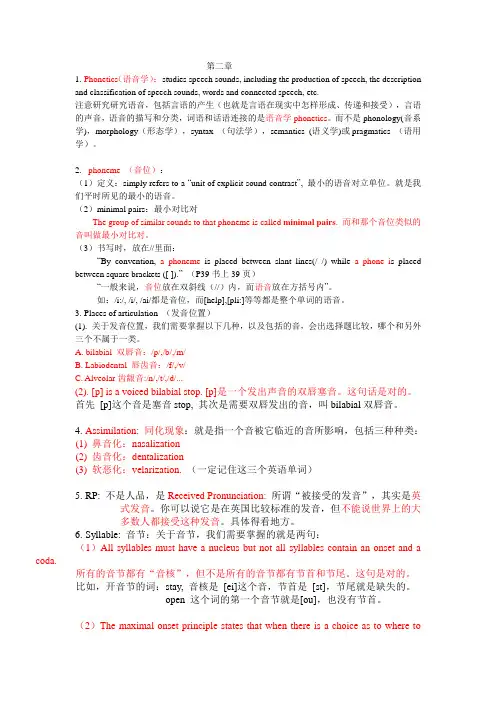
第二章1.Phonetics(语音学):studies speech sounds, including the production of speech, the descriptionand classification of speech sounds, words and connected speech, etc.注意研究研究语音,包括言语的产生(也就是言语在现实中怎样形成、传递和接受),言语的声音,语音的描写和分类,词语和话语连接的是语音学phonetics。
而不是phonology(音系学),morphology(形态学),syntax (句法学),semantics (语义学)或pragmatics (语用学)。
2.phoneme (音位):(1)定义:simply refers to a “unit of explicit sound contrast”, 最小的语音对立单位。
就是我们平时所见的最小的语音。
(2)minimal pairs:最小对比对The group of similar sounds to that phoneme is called minimal pairs. 而和那个音位类似的音叫做最小对比对。
(3)书写时,放在//里面:“By convention, a phoneme is placed between slant lines(/ /) while a phone i s placed between square brackets ([ ]).”(P39书上39页)“一般来说,音位放在双斜线(//)内,而语音放在方括号内”。
如:/i:/, /i/, /ai/都是音位,而[help],[pli:]等等都是整个单词的语音。
3.Places of articulation (发音位置)(1). 关于发音位置,我们需要掌握以下几种,以及包括的音,会出选择题比较,哪个和另外三个不属于一类。
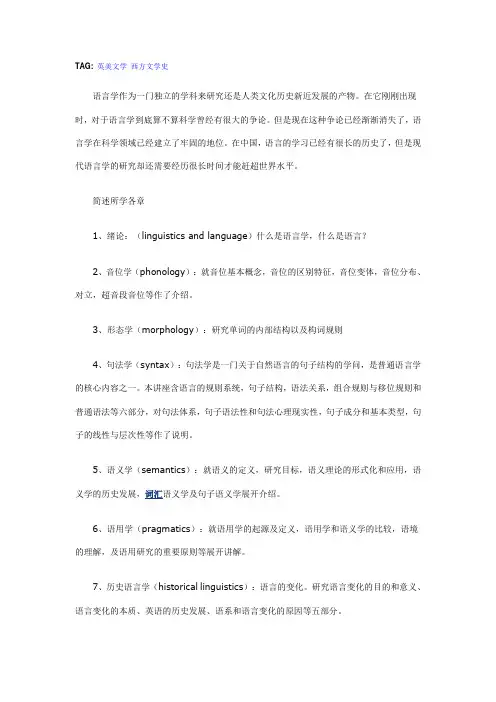
TAG:英美文学西方文学史语言学作为一门独立的学科来研究还是人类文化历史新近发展的产物。
在它刚刚出现时,对于语言学到底算不算科学曾经有很大的争论。
但是现在这种争论已经渐渐消失了,语言学在科学领域已经建立了牢固的地位。
在中国,语言的学习已经有很长的历史了,但是现代语言学的研究却还需要经历很长时间才能赶超世界水平。
简述所学各章1、绪论:(linguistics and language)什么是语言学,什么是语言?2、音位学(phonology):就音位基本概念,音位的区别特征,音位变体,音位分布、对立,超音段音位等作了介绍。
3、形态学(morphology):研究单词的内部结构以及构词规则4、句法学(syntax):句法学是一门关于自然语言的句子结构的学问,是普通语言学的核心内容之一。
本讲座含语言的规则系统,句子结构,语法关系,组合规则与移位规则和普通语法等六部分,对句法体系,句子语法性和句法心理现实性,句子成分和基本类型,句子的线性与层次性等作了说明。
5、语义学(semantics):就语义的定义,研究目标,语义理论的形式化和应用,语义学的历史发展,词汇语义学及句子语义学展开介绍。
6、语用学(pragmatics):就语用学的起源及定义,语用学和语义学的比较,语境的理解,及语用研究的重要原则等展开讲解。
7、历史语言学(historical linguistics):语言的变化。
研究语言变化的目的和意义、语言变化的本质、英语的历史发展、语系和语言变化的原因等五部分。
8、社会语言学(sociolinguistics):社会语境中的语言。
语言变异与语用情景、方言及方言使用的社会功能、双言与双语现象、少数民族方言、社会方言等五部分。
9、心理语言学(psycholinguistics):学习语言与心脑的关系。
包括语言的生理基础、语言侧化、语言中枢、失语症研究、语言习得的关键期和语言与思维的关系等六部分。
10、语言习得(language acquisition):人类语言能力的获得机器发展的过程。
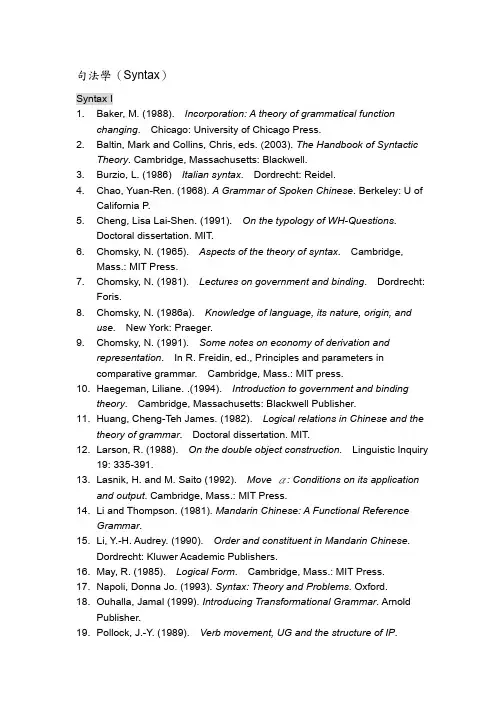
句法學(Syntax)Syntax I1. Baker, M. (1988). Incorporation: A theory of grammatical functionchanging. Chicago: University of Chicago Press.2. Baltin, Mark and Collins, Chris, eds. (2003). The Handbook of SyntacticTheory. Cambridge, Massachusetts: Blackwell.3. Burzio, L. (1986) Italian syntax. Dordrecht: Reidel.4. Chao, Yuan-Ren. (1968). A Grammar of Spoken Chinese. Berkeley: U ofCalifornia P.5. Cheng, Lisa Lai-Shen. (1991). On the typology of WH-Questions.Doctoral dissertation. MIT.6. Chomsky, N. (1965). Aspects of the theory of syntax. Cambridge,Mass.: MIT Press.7. Chomsky, N. (1981). Lectures on government and binding. Dordrecht:Foris.8. Chomsky, N. (1986a). Knowledge of language, its nature, origin, anduse. New York: Praeger.9. Chomsky, N. (1991). Some notes on economy of derivation andrepresentation. In R. Freidin, ed., Principles and parameters incomparative grammar. Cambridge, Mass.: MIT press.10. Haegeman, Liliane. .(1994). Introduction to government and bindingtheory. Cambridge, Massachusetts: Blackwell Publisher.11. Huang, Cheng-Teh James. (1982). Logical relations in Chinese and thetheory of grammar. Doctoral dissertation. MIT.12. Larson, R. (1988). On the double object construction. Linguistic Inquiry19: 335-391.13. Lasnik, H. and M. Saito (1992). Move α: Conditions on its applicationand output. Cambridge, Mass.: MIT Press.14. Li and Thompson. (1981). Mandarin Chinese: A Functional ReferenceGrammar.15. Li, Y.-H. Audrey. (1990). Order and constituent in Mandarin Chinese.Dordrecht: Kluwer Academic Publishers.16. May, R. (1985). Logical Form. Cambridge, Mass.: MIT Press.17. Napoli, Donna Jo. (1993). Syntax: Theory and Problems. Oxford.18. Ouhalla, Jamal (1999). Introducing Transformational Grammar. ArnoldPublisher.19. Pollock, J.-Y. (1989). Verb movement, UG and the structure of IP.Linguistic Inquiry 20: 365-424.20. Radford, Andrew. (1988). Transformational grammar: A first course.New York: Cambridge University.21. Radford, Andrew (1997). Syntactic theory and the structure of English.New York: Cambridge University.22. Rizzi, L. (1990). Relativized minimality. Cambridge, Mass.: MIT Press.Syntax IIBooks1. Chomsky, N. (1995). The minimalist program. Cambridge, Mass.: MITPress.2. Lasnik, H. (1999). Minimalist Analysis. Cambridge, Massachusetts:Blackwell.3. Poole, Geoffrey. (2002). Syntactic Theory. New York: Palgrave Macmillan. Articles4. Finer, D. L. (1991). “Binding Parameters in Second Language Acquisition”.Ed. Eubank, L. Point/Counterpoint Universal Grammar in the SecondLanguage. Amsterdam: John Benjamins, 351-374.5. Haegeman, L. (1990). Non-overt subjects in diary contexts. In Mascaro, J.and Nespor, M. editiors, Grammar in progress. GLOW essays for Henkvan Riesdijk. Dordrecht: Foris.6. Huang, C. T. James. (1984). “On the distribution and reference of emptypronouns.” Linguistics Inquiry. 15:531-74.7. Huang, C. T. James. (1990). Pro-drop in Chinese: A Generalized ControlTheory, in O. Jaeggli and K. Safir (ed.) The Null Subject Parameter.185-214.8. Huang, C. T. James and Tang, C. C. Jane (1991). The local nature of thelong-distance reflexive. Chinese, Long-distance Anaphora (eds.) by J.Koster and E. Reuland. Cambridge: Cambridge UP.9. Liceras, J. M. and Diaz, Lourdes. (1990). Topic-drop versus pro-drop: nullsubjects and pronominal subjects in the Spanish L2 of Chinese, English, French, German and Japanese speakers, Second Language research15,1: 1-40.10. Tang, C. C. Jane 1989, Chinese reflexives, Natural Language andLinguistic Theory. 7: 93-121.11. Tsai, W.-T. Dylan 2002, <自己、自性、與自然-談漢語中的反身狀語>,[self, Selfness, and Nature: on Reflexive Adverbials in Chinese], <中國語文>第四期12. White, L. (1985). The pro-drop parameter in adult second languageacquisition. Language Learning. 35: 531-74.13. Xu, L. (1993). “The long-distance binding of ziji.” Journal of ChineseLinguistics. 21:123-14214. Xu, L. (1994). “The Antecedent of ziji.” Journal of Chinese Linguistics. 22:115-136.Reference Journals15. Chinese Studies [漢學雜誌]16. Concentric[台師大英語系學報]17. Journal of East Asian Linguistics18. Journal of Chinese Linguistics19. Language and Philosophy20. Linguistic Inquiry21. Linguistic Review22. Tsing Hua Journal of Chinese Studies[清華學報]23. [中央研究院歷史語言所集刊]24. <中國語文>(大陸出版)。
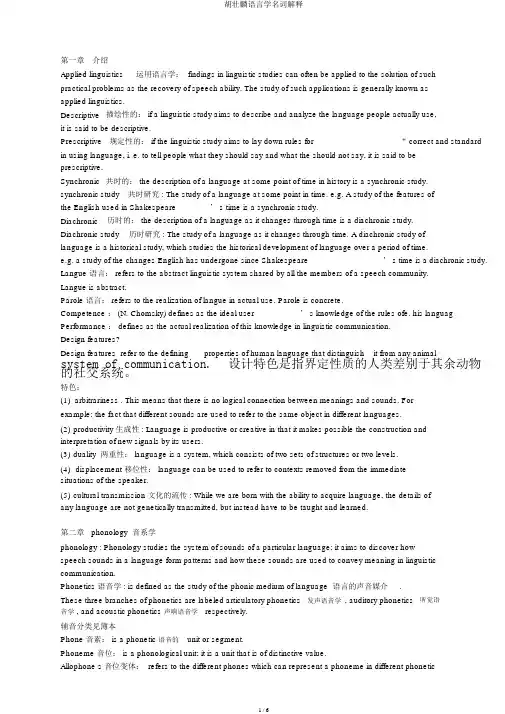
第一章介绍Applied linguistics运用语言学: findings in linguistic studies can often be applied to the solution of suchpractical problems as the recovery of speech ability. The study of such applications is generally known asapplied linguistics.Descriptive描绘性的: if a linguistic study aims to describe and analyze the language people actually use,it is said to be descriptive.Prescriptive规定性的: if the linguistic study aims to lay down rules for“ correct and standard in using language, i. e. to tell people what they should say and what the should not say, it is said to beprescriptive.Synchronic共时的: the description of a language at some point of time in history is a synchronic study.synchronic study共时研究 : The study of a language at some point in time. e.g. A study of the features ofthe English used in Shakespeare’ s time is a synchronic study.Diachronic历时的: the description of a language as it changes through time is a diachronic study.Diachronic study历时研究 : The study of a language as it changes through time. A diachronic study oflanguage is a historical study, which studies the historical development of language over a period of time.e.g. a study of the changes English has undergone since Shakespeare’ s time is a diachronic study. Langue 语言: refers to the abstract linguistic system shared by all the members of a speech community.Langue is abstract.Parole 语言: refers to the realization of langue in actual use. Parole is concrete.Competence : (N. Chomsky) defines as the ideal user’ s knowledge of the rules ofe. his languag Performance : defines as the actual realization of this knowledge in linguistic communication.Design features?Design features refer to the defining properties of human language that distinguish it from any animalsystem of communication. 设计特色是指界定性质的人类差别于其余动物的社交系统。
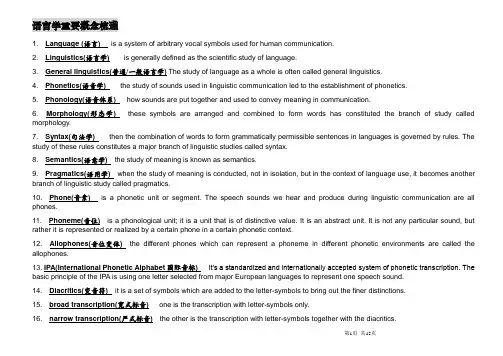
语言学重要概念梳理1. Language (语言) is a system of arbitrary vocal symbols used for human communication.2. Linguistics(语言学)is generally defined as the scientific study of language.3. General linguistics(普通/一般语言学) The study of language as a whole is often called general linguistics.4. Phonetics(语音学) the study of sounds used in linguistic communication led to the establishment of phonetics.5. Phonology(语音体系) how sounds are put together and used to convey meaning in communication.6. Morphology(形态学) these symbols are arranged and combined to form words has constituted the branch of study called morphology.7. Syntax(句法学) then the combination of words to form grammatically permissible sentences in languages is governed by rules. The study of these rules constitutes a major branch of linguistic studies called syntax.8. Semantics(语意学) the study of meaning is known as semantics.9. Pragmatics(语用学) when the study of meaning is conducted, not in isolation, but in the context of language use, it becomes another branch of linguistic study called pragmatics.10. Phone(音素) is a phonetic unit or segment. The speech sounds we hear and produce during linguistic communication are all phones.11. Phoneme(音位)is a phonological unit; it is a unit that is of distinctive value. It is an abstract unit. It is not any particular sound, but rather it is represented or realized by a certain phone in a certain phonetic context.12. Allophones(音位变体) the different phones which can represent a phoneme in different phonetic environments are called the allophones.13. IPA(International Phonetic Alphabet国际音标) It’s a standardized and internationally accepted system of phonetic transcription. The basic principle of the IPA is using one letter selected from major European languages to represent one speech sound.14. Diacritics(变音符) it is a set of symbols which are added to the letter-symbols to bring out the finer distinctions.15.broad transcription(宽式标音) one is the transcription with letter-symbols only.16.narrow transcription(严式标音) the other is the transcription with letter-symbols together with the diacritics.17. open class words(开放类词)In English , open class words are nouns, verbs, adjectives and adverbs. We can regularly add new words to these classes.18. closed class words(封闭类词) In English , closed class word are conjunctions, prepositions, articles and pronouns. New words are not usually added to them.19. Morpheme(词素) the most basic element of meaning is traditionally called morpheme.20. bound morpheme(黏着词素) morphemes which occurs only before other morphemes. They cannot be used alone.21. free morpheme(自由词素)it is the morphemes which can be used alone.22. suprasegmental features(超音段特征) the phonemic features that occur above the level of the segments are called suprasegmental features.23. Category(范畴) it refers to a group of linguistic items which fulfill the same or similar functions in a particular language such as a sentence ,a noun phrase or a verb.24. Phrases(短语) Syntactic units that are built around a certain word category are called phrases.1. Three distinct of phonetics(语音学的三个分支?)Articulatory phonetics发音语音学; auditory phonetics听觉语音学; acoustic phonetics声光语音学.2. Main features of language(语言的主要特征?)Language is a system. Language is arbitrary. Language is vocal. Language is human-specific.3. Synchronic vs. diachronic(共识语言学与历史语言学的区别?)Language exists in time and changes through time. The description of a language at some point of time in history is a synchronic study; the description of a language as it changes through time is a diachronic study. A diachronic study of language is a historical study; it studies the historical development of language over a period of time.4. Speech and writing (言语与文字的区别?)Speech and writing are the two major media of linguistic communication. From the point of view of linguistic evolution, speech is prior to writing. The writing system of any language is always “invented” by its users to record speech when the need arises. Then in everyday communication, speech plays a greater role than writing in terms of the amount of information conveyed, speech is always the way in which every native speaker acquires his mother tongue, and writing is learned and taught later when he goes to school. Written language is only the “revised” record of speech.5. What are the branches of linguistic study?(语言学研究领域中的主要分支有哪些?)1) sociolinguistics; 2) psycholinguistics; 3)applied linguistics and so on.6. Traditional grammar and modern linguistics(传统语法与现代语言学的区别?)Firstly, linguistics is descriptive while traditional grammar is prescriptive.Second, modern linguistics regards the spoken language as primary, not the written. Traditional grammarians, tended to emphasize, maybe over-emphasize, the importance of the written word.Modern linguistics differs from traditional grammar also in that it does not force languages into a Latin-based framework.7. Prescriptive vs. descriptive (语言学中描写性与规定性的特征是什么?)Prescriptive and descriptive represent two different types of linguistic study. If a linguistic study aims to describe and analyze the language people actually use, it is said to be descriptive; if the linguistic study aims to lay down rules for “correct and standard” behavior in using language, it is said to be prescriptive.8. Design features of language (语言的识别特征?)Arbitrariness随意性,productivity生产性, duality 二重性, displacement 不受时空限制的特征, cultural transmission 文化传递系统.9. Competence and performance (语言能力与语言行为的区别?)Competence is defined as the ideal user’s knowledge of the rules of his language, and performan ce the actual realization of this knowledge in linguistic communication. Chomsky looks at language from a psychological point of view and to him competence is a property of the mind of each individual.10. Organs of speech (发音器官)Pharyngeal cavity—the throat, oral cavity—the mouth, nasal cavity—the nose.11. Word-level categories(决定词范畴的三个标准)To determine a word’s category, three criteria are usually employed, namely meaning, inflection and distribution.1. Some rules in phonology(音位学规则)sequential rules(序列规则);assimilation rule (同化规则) ;deletion rule(省略规则)。
自考《现代语言学》复习讲义一、常考题型1.填空2.单项选择3.判断正误4.解释词语并举例说明对名词解释并举一两个例子进行说明5.回答问题做题要求:用英文进行答题。
二、各章节学习要点Chapter 1 Introduction (绪论)is linguisticsDefinition (语言学的定义)Linguistics is generally defined as the scientific study of language.Linguistics studies not any particular language, ., English, Chinese, Arabic, and Latin, but in language in general.The Scope of linguistics (语言学的研究范畴)—4The study of language as a whole is often called general linguistics(普通语言学).This deals with the basic concepts, theories, descriptions, models and methods applicable in any linguistic study, in contrast to those branches of study which relate linguistics tothe research of other areas.Main branches of linguistics 语言学的主要分支:1)phonetics(语音学) 2)phonology (音系学) 3)morphology (形态学) 4)syntax (句法学) 5)semantics (语义学) 6)pragmatics (语用学)The study of all these aspects of language forms the core of linguistics.Findings in linguistic studies can often be applie3d to the solution of such practical problems as the recovery of speech ability. The study of such applications is generally known as applied linguistics.Macrolinguistics 宏观语言学:1) Psycholingusitcs (心理语言学);2) Sociolinguistics (社会语言学);3) Anthropological linguistics (人类语言学);4) Computational linguistics (计算语言学)Some important distinctions in linguistics —71.3.1 Prescriptive vs. descriptive (规定性和描述性)Modern linguistics, ., linguistic study carried out in this century is mostly descriptive.1.3.2 Synchronic vs. diachronic (共时性和历时性)In modern linguistics, synchronic study seems to enjoy priority over diachronic study.1.3.3 Speech and writing (口头语和书面语)Speech and writing are the two major media of communication. Modern linguistics regards the spoken language as primary, not the written.1.3.4 Langue and parole (语言和言语)The distinction between langue and parole was made by the Swiss linguist F. de Saussure in the early 20th century.1.3.5 Competence and performance (语言能力和语言运用)Similar to Saussure’s distinction between langue and parole is the distinction between competence and performance, which was proposed by the American linguist N. Chomsky in the late 1950’s.While Saussure’s distinction and Chomsky’s are very similar, they differ at least in that Saussure took a sociological view of language and his notion of langue is a matter of social conventions, and Chomsky looks at language from a psychological point of view and to him competence is a property of the mind of each individual.2. What is languageDefinitions of languageLanguage is a system of arbitrary vocal symbols used for human communication.(语言是人类在交际中使用的一套任意的声音符号系统。
英语语言学专业术语英语语言学是研究英语语言的起源、发展、结构和使用的学科。
以下是常见的英语语言学专业术语及其解释。
1. Phonetics(音系学):研究语音的学科。
主要研究语音发音过程,包括语音的组成、发音方式和特点等。
2. Phonology(音韵学):研究语音在语言中的功能和规律的学科。
主要研究语音在不同语境下的变化规律和相互关系,包括音素、音位和音系等。
3. Morphology(形态学):研究语言中单词的形态和构成的学科。
主要研究单词的基本单位和构成规律,包括词根、词缀和词类等。
4. Syntax(句法学):研究句子结构和句子组成的学科。
主要研究句子的构成和排列方式,包括短语、从句和主谓结构等。
5. Semantics(语义学):研究语言意义的学科。
主要研究语言符号和意义之间的关系,包括单词、短语和句子的意义等。
6. Pragmatics(语用学):研究语言使用的学科。
主要研究语言与社会文化环境的关系,包括语境、语用规则和交际意图等。
7. Discourse analysis(话语分析):研究语篇结构和语篇功能的学科。
主要研究语言在话语交际中的组织和作用,包括话语行为、话语结构和话语分析方法等。
8. Sociolinguistics(社会语言学):研究语言和社会文化因素之间的关系和影响的学科。
主要研究不同社会群体、文化背景和地理区域中语言使用的差异和变化,包括方言、语言变体和语言政策等。
9. Psycholinguistics(心理语言学):研究语言和心理过程之间的关系的学科。
主要研究语言理解、语言产生和语言习得等心理过程,包括语音知觉、语法处理和语言记忆等。
以上是英语语言学常见的专业术语及其解释,希望能够帮助你更好地了解英语语言学。
Chapter 1 Language语言1. Design feature (识别特征) refers to the defining properties of human language that distinguish it from any animal system of communication.2. Productivity(能产性) refers to the ability that people have in making and comprehending indefinitely large quantities of sentences in theirnative language.3. arbitrariness (任意性) Arbitrariness refers to the phenomenon that there is no motivated relationship between a linguistic form and itsmeaning.4. symbol (符号) Symbol refers to something such as an object, word, or sound that represents something else by association or convention.5. discreteness (离散性) Discreteness refers to the phenomenon that the sounds in a language are meaningfully distinct.6. displacement (不受时空限制的特性) Displacement refers to the fact that human language can be used to talk about things that are not in theimmediate situations of its users.7. duality of structure (结构二重性) The organization of language into two levels, one of sounds, the other of meaning, is known as duality ofstructure.8. culture transmission (文化传播) Culture transmission refers to the fact that language is passed on from one generation to the next throughteaching and learning, rather than by inheritance.9. interchangeability (互换性) Interchangeability means that any human being can be both a producer and a receiver of messages.1. ★What is language?Language is a system of arbitrary vocal symbols used for human communication. This definition has captured the main features of language.First, language is a system.Second, language is arbitrary in the sense.The third feature of language is symbolic nature.2. ★What are the design features of language?Language has seven design features as following:1) Productivity.2) Discreteness.3) Displacement4) Arbitrariness.5) Cultural transmission6) Duality of structure.7) Interchangeability.3. Why do we say language is a system?Because elements of language are combined according to rules, and every language contains a set of rules. By system, the recurring patterns or arrangements or the particular ways or designs in which a language operates. And the sounds, the words and the sentences are used in fixed patterns that speaker of a language can understand each other.4. ★ (Function of language.) According to Halliday, what are the initial functions of children’s language? And what are the threefunctional components of adult language?I. Halliday uses the following terms to refer to the initial functions of children’s language:1) Instrumental function. 工具功能2) Regulatory function. 调节功能3) Representational function. 表现功能4) Interactional function. 互动功能5) Personal function. 自指性功能6) Heuristic function. 启发功能[osbQtq`kf`h]7) Imaginative function. 想象功能II. Adult language has three functional components as following:1) Interpersonal components. 人际2) Ideational components.概念3) Textual components.语篇1. general linguistics and descriptive linguistics (普通语言学与描写语言学) The former deals with language in general whereas the latter isconcerned with one particular language.2. synchronic linguistics and diachronic linguistics (共时语言学与历时语言学) Diachronic linguistics traces the historical development of thelanguage and records the changes that have taken place in it between successive points in time. And synchronic linguistics presents an account of language as it is at some particular point in time.3. theoretical linguistics and applied linguistics (理论语言学与应用语言学) The former copes with languages with a view to establishing atheory of their structures and functions whereas the latter is concerned with the application of the concepts and findings of linguistics to all sorts of practical tasks.4. microlinguistics and macrolinguistics(微观语言学与宏观语言学) The former studies only the structure of language system whereas thelatter deals with everything that is related to languages.5. langue and parole (语言与言语) The former refers to the abstract linguistics system shared by all the members of a speech communitywhereas the latter refers to the concrete act of speaking in actual situation by an individual speaker.6. competence and performance (语言能力与语言运用) The former is one’s knowledge of all the linguistic regulation systems whereas the latteris the use of language in concrete situation.7. speech and writing (口头语与书面语) Speech is the spoken form of language whereas writing is written codes, gives language new scope.8. linguistics behavior potential and actual linguistic behavior (语言行为潜势与实际语言行为) People actually says on a certain occasion to acertain person is actual linguistics behavior. And each of possible linguistic items that he could have said is linguistic behavior potential.9. syntagmatic relation and paradigmatic relation(横组合关系与纵聚合关系) The former describes the horizontal dimension of a languagewhile the latter describes the vertical dimension of a language.10. verbal communication and non-verbal communication(言语交际与非言语交际) Usual use of language as a means of transmittinginformation is called verbal communication. The ways we convey meaning without using language is called non-verbal communication.1. ★How does John Lyons classify linguistics?According to John Lyons, the field of linguistics as a whole can be divided into several subfields as following:1) General linguistics and descriptive linguistics.2) Synchronic linguistics and diachronic linguistics.3) Theoretical linguistics and applied linguistics.4) Microlinguistics and macrolinguistics.2. Explain the three principles by which the linguist is guided: consistency, adequacy and simplicity.1) Consistency means that there should be no contradictions between different parts of the theory and the description.2) Adequacy means that the theory must be broad enough in scope to offer significant generalizations.3) Simplicity requires us to be as brief and economic as possible.3. ★What are the sub-branches of linguistics within the language system?Within the language system there are six sub-branches as following:1) Phonetics. 语音学is a study of speech sounds of all human languages.2) Phonology. 音位学studies about the sounds and sound patterns of a speaker’s native language.3) Morphology. 形态学studies about how a word is formed.4) Syntax. 句法学studies about whether a sentence is grammatical or not.5) Semantics. 语义学studies about the meaning of language, including meaning of words and meaning of sentences.6) Pragmatics. 语用学★The scope of language: Linguistics is referred to as a scientific study of language.★The scientific process of linguistic study: It involves four stages: collecting data, forming a hypothesis, testing the hypothesis and drawing conclusions.1. articulatory phonetics(发音语音学) The study of how speech organs produce the sounds is called articulatory phonetics.2. acoustic phonetics (声学语音学) The study of the physical properties and of the transmission of speech sounds is called acoustic phonetics.3. auditory phonetics (听觉语音学) The study of the way hearers perceive speech sounds is called auditory phonetics.4. consonant (辅音) Consonant is a speech sound where the air form the language is either completely blocked, or partially blocked, or where theopening between the speech organs is so narrow that the air escapes with audible friction.5. vowel (元音) is defined as a speech sound in which the air from the lungs is not blocked in any way and is pronounced with vocal-cord vibration.6. bilabials (双唇音) Bilabials means that consonants for which the flow of air is stopped or restricted by the two lips. [p][b] [m] [w]7. affricates (塞擦音) The sound produced by stopping the airstream and then immediately releasing it slowly is called affricates. [t X] [d Y] [tr] [dr]8. glottis (声门) Glottis is the space between the vocal cords.9. rounded vowel (圆唇元音) Rounded vowel is defined as the vowel sound pronounced by the lips forming a circular opening. [u:] [u] [OB] [O]10. diphthongs (双元音) Diphthongs are produced by moving from one vowel position to another through intervening positions.[ei][ai][O i] [Q u][au]11. triphthongs(三合元音) Triphthongs are those which are produced by moving from one vowel position to another and then rapidly andcontinuously to a third one. [ei Q][ai Q][O i Q] [Q u Q][au Q]12. lax vowels (松元音) According to distinction of long and short vowels, vowels are classified tense vowels and lax vowels. All the long vowelsare tense vowels but of the short vowels,[e] is a tense vowel as well, and the rest short vowels are lax vowels.1. ★How are consonants classified in terms of different criteria?The consonants in English can be described in terms of four dimensions.1) The position of the soft palate.2) The presence or the absence of vocal-cord vibration.3) The place of articulation.4) The manner of articulation.2. ★How are vowels classified in terms of different criteria?Vowel sounds are differentiated by a number of factors.1) The state of the velum2) The position of the tongue.3) The openness of the mouth.4) The shape of the lips.5) The length of the vowels.6) The tension of the muscles at pharynx.3. ★What are the three sub-branches of phonetics? How do they differ from each other?Phonetics has three sub-branches as following:1) Articulatory phonetics is the study of how speech organs produce the sounds is called articulatory phonetics.2) Acoustic phonetics is the study of the physical properties and of the transmission of speech sounds is called acoustic phonetics.3) Auditory phonetics is the study of the way hearers perceive speech sounds is called auditory phonetics.4. ★What are the commonly used phonetic features for consonants and vowels respectively?I. The frequently used phonetic features for consonants include the following:1) Voiced.2) Nasal.3) Consonantal.4) Vocalic.5) Continuant.6) Anterior.7) Coronal.8) Aspirated.II. The most common phonetic features for vowels include the following:1) High.2) Low.3) Front.4) Back.5) Rounded.6) Tense.1. phonemes (音位) Phonemes are minimal distinctive units in the sound system of a language.2. allophones (音位变体) Allophones are the phonetic variants and realizations of a particular phoneme.3. phones (单音) The smallest identifiable phonetic unit found in a stream of speech is called a phone.4. minimal pair (最小对立体) Minimal pair means words which differ from each other only by one sound.5. contrastive distribution (对比分布) If two or more sounds can occur in the same environment and the substitution of one sound for anotherbrings about a change of meaning, they are said to be in contrastive distribution.6. complementary distribution(互补分布) If two or more sounds never appear in the same environment ,then they are said to be incomplementary distribution.7. free variation (自由变异) When two sounds can appear in the same environment and the substitution of one for the other does not cause anychange in meaning, then they are said to be in free variation.8. distinctive features (区别性特征) A distinctive feature is a feature which distinguishes one phoneme from another.9. suprasegmental features (超切分特征) The distinctive (phonological) features which apply to groups larger than the single segment are knownas suprasegmental features.10. tone languages (声调语言) Tone languages are those which use pitch to contrast meaning at word level.11. intonation languages (语调语言) Intonation languages are those which use pitch to distinguish meaning at phrase level or sentence level.12. juncture (连音) Juncture refers to the phonetic boundary features which may demarcate grammatical units.1. ★What are the differences between English phonetics and English phonology?1) Phonetics is the study of the production, perception, and physical properties of speech sounds, while phonology attempts to account forhow they are combined, organized, and convey meaning in particular languages.2) Phonetics is the study of the actual sounds while phonology is concerned with a more abstract description of speech sounds and tries todescribe the regularities of sound patterns.2. Give examples to illustrate the relationship between phonemes, phones and allophones.When we hear [pit],[tip],[spit],etc, the similar phones we have heard are /p/. And /p/ and /b/ are separate phonemes in English, while [ph] and [p] are allophones.3. How can we decide a minimal pair or a minimal set?A minimal pair should meet three conditions:1) The two forms are different in meaning.2) The two forms are different in one sound segment.3) The different sounds occur in the same position of the two strings.4. ★Use examples to explain the three types of distribution.1) Contrastive distribution. Sounds [m] in met and [n] in net are in contrastive distribution because substituting [m] for [n] will result in achange of meaning.2) Complementary distribution. The aspirated plosive [ph] and the unaspirated plosive [p] are in complementary distribution because theformer occurs either initially in a word or initially in a stressed syllable while the latter never occurs in such environments.3) Free variation. In English, the word “direct” may be pronounce in two ways: /di’rekt/ and /dia’rekt/, and the two different sounds /i/ and /ai/can be said to be in free variation.5. What’s the difference between segmental features and suprasegmental features? What are the suprasegmental features in English?I. 1) Distinctive features, which are used to distinguish one phoneme from another and thus have effect on one sound segment, are referred toas segmental features.2) The distinctive (phonological) features which apply to groups larger than the single segment are known as suprasegmental features.3) Suprasegmental features may have effect on more than one sound segment. They may apply to a string of several sounds.II.The main suprasegmental features include stress, tone, intonation and juncture.6. What’s the difference between tone languages and intonation language?Tone languages are those which use pitch to contrast meaning at word level while intonation languages are those which use pitch to distinguish meaning at phrase level or sentence level7. ★What’s the difference between phonetic transcriptions and phonemic transcriptions?The former was meant to symbolize all possible speech sounds, including even the most minute shades of pronunciation, while the latter was intended to indicate only those sounds capable of distinguishing one word from another in a given language.1. morphemes (语素) Morphemes are the minimal meaningful units in the grammatical system of a language.allomorphs (语素变体) Allomorphs are the realizations of a particular morpheme.morphs (形素) Morphs are the realizations of morphemes in general and are the actual forms used to realize morphemes.2. roots (词根) Roots is defined as the most important part of a word that carries the principal meaning.affixes (词缀) Affixes are morphemes that lexically depend on roots and do not convey the fundamental meaning of words.free morphemes (自由语素) Free morphemes are those which can exist as individual words.bound morphemes (粘着语素) Bound morphemes are those which cannot occur on their own as separate words.3. inflectional affixes (屈折词缀) refer to affixes that serve to indicate grammatical relations, but do not change its part of speech.derivational affixes (派生词缀) refer to affixes that are added to words in order to change its grammatical category or its meaning.4. empty morph (空语子) Empty morph means a morph which has form but no meaning.zero morph (零语子) Zero morph refers to a morph which has meaning but no form.5. IC Analysis (直接成分分析) IC analysis is the analysis to analyze a linguistic expression (both a word and a sentence) into a hierarchicallydefined series of constituents.6. immediate constituents(直接成分) A immediate constituent is any one of the largest grammatical units that constitute a construction.Immediate constituents are often further reducible.ultimate constituents (最后成分) Ultimate constituents are those grammatically irreducible units that constitute constructions.7. morphological rules (形态学规则) The principles that determine how morphemes are combined into new words are said to be morphologicalrules.8. word-formation process (构词法) Word-formation process mean the rule-governed processes of forming new words on the basis of alreadyexisting linguistic resources.1. ★What is IC Analysis?IC analysis is the analysis to analyze a linguistic expression (both a word and a sentence) into a hierarchically defined series of constituents.2. How are morphemes classified?1) Semantically speaking, morphemes are grouped into two categories: root morphemes and affixational morphemes.2) Structurally speaking, they are divided into two types: free morphemes and bound morphemes.3. ★Explain the interrelations between semantic and structural classifications of morphemes.a) All free morphemes are roots but not all roots are free morphemes.b) All affixes are bound morphemes, but not all bound morphemes are affixes.4. What’s the difference between an empty morph and a zero mor ph?a) Empty morph means a morph that has form but no meaning.b) Zero morph refers to a morph that has meaning but no form.5. Explain the differences between inflectional and derivational affixes in term of both function and position.a) Functionally:i.Inflectional affixes sever to mark grammatical relations and never create new words while derivational affixes can create new words.ii.Inflectional affixes do not cause a change in grammatical class while derivational affixes very often but not always cause a change in grammatical class.b) In term of position:i.Inflectional affixes are suffixes while derivational affixes can be suffixes or prefixes.ii.Inflectional affixes are always after derivational affixes if both are present. And derivational affixes are always before inflectional suffixes if both are present.6. What are morphological rules? Give at least four rules with examples.The principles that determine how morphemes are combined into new words are said to be morphological rules.For example:a) un- + adj. ->adj.b) Adj./n. + -ify ->v.c) V. + -able -> adj.d) Adj. + -ly -> adv.1. syntagmatic relations (横组关系) refer to the relationships between constituents in a construction.paradigmatic relations (纵聚合关系) refer to the relations between the linguistic elements within a sentence and those outside the sentence.hierarchical relations (等级关系) refer to relationships between any classification of linguistic units which recognizes a series of successively subordinate levels.2. IC Analysis (直接成分分析) is a kind of grammatical analysis, which make major divisions at any level within a syntactic construction.labeled IC Analysis(标记法直接成分分析) is a kind of grammatical analysis, which make major divisions at any level within a syntactic construction and label each constituent.phrase markers (短语标记法) is a kind of grammatical analysis, which make major divisions at any level within a syntactic construction, and label each constituent while remove all the linguistic forms.labeled bracketing (方括号标记法) is a kind of grammatical analysis, which is applied in representing the hierarchical structure of sentences by using brackets.3. constituency (成分关系)dependency (依存关系)4. surface structures (表层结构)refers to the mental representation of a linguistic expression, derived from deep structure by transformationalrules.deep structures (深层结构) deep structure of a linguistic expression is a theoretical construct that seeks to unify several related structures. 5. phrase structure rules (短语结构规则)are a way to describe a given language's syntax. They are used to break a natural language sentencedown into its constituent parts.6. transformational rules (转换规则)7. structural ambiguity (结构歧义)1. What are the differences between surface structure and deep structure?They are different from each other in four aspects:1) Surface structures correspond directly to the linear arrangements of sentences while deep structures correspond to the meaningful groupingof sentences.2) Surface structures are more concrete while deep structures are more abstract.3) Surface structures give the forms of sentences whereas deep structures give the meanings of sentences.4) Surface structures are pronounceable but deep structures are not.2. Illustrate the differences between PS rules and T-rules.1) PS rules frequently applied in generating deep structures.2) T-rules are used to transform deep structure into surface structures.3. What’s the order of generating sentences? Do we st art with surface structures or with deep structures? How differently are theygenerated?To generate a sentence, we always start with its deep structure, and then transform it into its corresponding surface structure.Deep structures are generated by phrase structure rules (PS rules) while surface structures are derived from their deep structures by transformational rules (T-rules).4. What’s the difference between a compulsory constituent and an optional one?Optional constituents may be present or absent while compulsory constituents must be present.5. What are the three syntactic relations? Illustrate them with examples.1) Syntagmatic relations2) Paradigmatic relations.3) Hierarchical relations.1. Lexical semantics (词汇语义学) is defined as the study of word meaning in language.2. Sense (意义) refers to the inherent meaning of the linguistic form.3. Reference (所指) means what a linguistic form refers to in the real world.4. Concept (概念) is the result of human cognition, reflecting the objective world in the human mind.5. Denotation (外延) is defined as the constant ,abstract, and basic meaning of a linguistic expression independent of context and situation.6. Connotation (内涵) refers to the emotional associations which are suggested by, or are part of the meaning of, a linguistic unit.7. Componential analysis (成分分析法) is the way to decompose the meaning of a word into its components.8. Semantic field (语义场) The vocabulary of a language is not simply a listing of independent items, but is organized into areas, within whichwords interrelate and define each other in various ways. The areas are semantic fields.9. Hyponymy (上下义关系) refers to the sense relation between a more general, more inclusive word and a more specific word.10. Synonymy (同义关系) refers to the sameness or close similarity of meaning.11. Antonymy (反义关系) refers to the oppositeness of meaning.12. Lexical ambiguity (词汇歧义)13. Polysemy (多义性) refers to the fact that the same one word may have more than one meaning.14. Homonymy (同音(同形)异义关系) refers to the phenomenon that words having different meanings have the same form.15. Sentence semantics (句子语义学) refers to the study of sentence meaning in language.1. What’s the criterion of John Lyons in classifying semantics into its sub-branches? And how does he classify semantics?In terms of whether it falls within the scope of linguistics, John Lyons distinguishes between linguistic semantics and non-linguistic semantics.According John Lyons, semantics is one of the sub-branches of linguistics; it is generally defined as the study of meaning.2. What are the essential factors for determining sentence meaning?1) Object, 2) concept, 3) symbol, 4) user, 5) context.3. What is the difference between the theory of componential analysis and the theory of semantic theory in defining meaning of words?4. What are the sense relations between sentences?1) S1 is synonymous with S2.2) S1 entails S2.3) S1 contradicts S2.4) S1 presupposes S2.5) S1 is a tautology, and therefore invariably true.6) S1 is a contradiction, and therefore invariably false.7) S1 is semantically anomalous.1. Speech act theory (言语行为理论)2. Cooperative principle and its maxims (合作原则及其准则)3. Politeness principle and its maxims (礼貌原则及其准则)4. Conversational implicature (会话含义)5. Indirect speech act (间接言语行为)6. Pragmatic presupposition (语用学预设)7. Relevance theory (关联理论)8. Illocutionary act (言外行为)9. (Horn’s) Q-Principle and R-Principle10. Perfrmative verbs (施为句动词)1. Make comments on the different definitions of pragmatics.2. What are the main types of deixis?3. Explain the statement: context is so indispen sable in fully understanding interpreting the speaker’s meaning.4. How are Austin’s and Searle’s speech act theories related to each other?5. What’s the relationship between CP and PP?6. What do you know about presupposition triggers in English? Explain them briefly with examples.7. What is ostensive-referential communication?8. Explain the obvious presupposition of speaker who say each of the following:1) When did you stop beating your wife?2) Where did Tom buy the watch?3) Your car is broken.9. What do you think of the fol lowing statement? “Tom participated in spreading rumors” entails “Tom engaged in spreading rumors”.Chapter 9 话语分析1. text(语篇) = discourse 语篇是指实际使用的语言单位,是一次交际过程中的一系列连续的话段或句子所构成的语言整体。
第一章:Linguistics is generally defined as the scientific study of language.(语言学普遍被定义为对语言进行的科学研究.)Language is a system of arbitrary vocal symbols used for human communication.(语言是用于人类交际目的的一套任意的有声符号系统.)The scope of linguistics(语言学的研究视野):1.phonetics(语音学)2.phonology(音位学)3.morphology(形态学)4.syntax(句法学)5.semantics(语义学)6.pragmatics(语用学)Some important distinctions in linguistics(语言学中的一些重要区分):1.prescriptive & descriptive(规定性与描写性)2.synchronic & diachronic(共时性与历时性)3.speech and writing(言语与文字)nguage and parole(语言与言语)petence and performance(语言能力与语言运用)6.traditional grammar and modern linguistics(传统语法与现代语言学)The difference between traditional grammar and modern linguistics(传统语法与现代语言学之间的异同点):1.Linguistics is descriptive while traditional grammar is prescriptive.2.Modern linguistics regards the spoken language as primary, not the written.3.Modern linguistics differs from traditional grammar also in that it does not force languages into a Latin-based framework.The design/defining features of human language(语言的甄别性特征):1.Arbitrariness(语言的武断性/任意性)2. Productivity(语言的创造性)3.Duality(语言的二重性)4.Displacement(语言的移位性)5.Cultural transmission(语言的文化传递性)第二章:Phonetics(语音学) is defined as the study of the phonic medium of language; it is concerned with all the sounds th at occur in the world’s languages.(语音学指的是对语言的语音媒介进行的研究)Three branches of phonetics:1.Articulatory phonetics(发音语音学)—from the speakers’ point of view,”how speakers produce speech sounds.”2.Auditory phonetics(听觉语音学)—from the hearer’s point of view,”how sounds are perceived.”3.Acoustic phonetics(声学语音学)—from the physical way or means by which sounds are transmitted from one to another.Speech organs(发音器官):three important areas:1.the pharyngeal cavity(咽腔)----the throat2.the oral cavity(口腔)----the mouth3.the nasal cavity(鼻腔)----the noseThe diagram of speech organs:1.lips(唇)2.teeth(齿)3.teeth ridge(alveolus)(牙齿/龈)4.hard palate(硬腭)5.soft palate(velum)(软腭)6.uvula(小舌)7.tip of tongue(舌尖)8.blade of tongue(舌面)9.back of tongue(舌后) 10.vocal cords(声带) 11.pharyngeal cavity(咽腔) 12.nasal cavity(鼻腔)Orthographic representation of speech sounds(语音的正字法表征):1. A standardized and internationally accepted system of phonetic transcription is the International Phonetic Alphabet(IPA)国际音标.2. The basic principle of the IPA is using one letter to represent one speech sound.(其基本原则是一个字母待变一个音.)Braod transcription(宽式标音)----used in dictionary and textbook for general purpose, without diacritics.Narrow transcription(严式标音)----used by phonetician for careful study, with diacritics.Classification of English consonants(辅音的分类):Ⅰ、in terms of manner of articulation(发音方式):1.stops(闭塞音)/plosives(爆破音)2.fricatives(摩擦音)3.affricates(塞擦音)4.liquids(流音)5.nasals(鼻音)6.glides(滑音)/semivowels(半元音)Ⅱ、in terms of place of articulation(发音部位):1.bilabial(双唇音)biodental(唇齿音)3.dental(齿音)4.alveolar(齿龈音)5.palatal(腭音)6.velar(软腭音)7.glottal(喉音)Classification of English vowels(元音的分类):1.monophthongs or pure/single vowels(单元音)2.diphthongs(双元音)Phonology(音位学) studies the patterning of speech sounds, that is , the ways in which speech sounds forms systems and patterns in human languages.(音位学研究的是语音如何组合在一起并在交流中传达意义.)Phone(音素):a phone is a phonetic unit or segment. The speech sounds we hear and produce during linguistic communication are all phones.(音素是一个语音单位或者说语音段.我们在语言交际中听到的、发出的语音都是音素。
1.1 Linguistics is generally defined as the scientific study of language . The study of language as a whole if often called general linguistics . phonetics(语音学): the study of sounds phonology(音位学): how sounds are put together and used to convey meaning Lexicon / morphology(形态学): how morphemes(词素) are arranged and combined to form words syntax(句法学): the study of rules that govern the combination of words to form grammatically permissible sentences semantics(语义学): the study of meaning pragmatics(语用学): the study of meaning in the context of language use interdisciplinary branches: sociolinguistics(社会语言学), psycholinguistics(心理语言学), applied linguistics(应用语言学) Important distinctions in linguistics prescriptive(规定性 old linguistics) vs. descriptive(描述性 modern linguistics) synchronic(共时性) vs. diachronic(历时性) 1.2 Language is a system of arbitrary vocal symbols used for human communication. Arbitrariness (任意性): Different sounds are used to refer to the same object in different languages. Productivity/creativity (能产性): Construction and interpretation of new signals are possible, so that large number of sentences can be produced. Duality (双层性): Two levels enable people to talk about anything within their knowledge. lower level(sounds)---higher level(words) Displacement(移位性): enable people to talk about a wide range of things, free from barriers caused by separation in time or place. Cultural transmission(文化传承): We are born with the ability to acquire language, the details of language system have to be taught and learned. Phonetics (语音学)(定义) Phonetics: the study of the phonic medium of language: it is concerned with all the sounds that occur in the world’s languages.(是指对语言的语音媒介进行的研究,它关注语言世界中的所有语音) Three branches of phonetics: articulatory phonetics (发音)auditory phonetics (听觉)acoustic phonetics (声学) Orthographic representation of speech sounds :Broad transcription and Narrow transcription A standardized and internationally accepted system of phonetic transcription is the International Phonetic Alphabet (IPA). The basic principle of the IPA is using one letter to represent one speech sound. Phonetics & phonology :(定义,区别) Both are concerned with the same aspect of language: the speech sounds. But they differ in their approach and focus. Phonetics is of a general nature; it is interested in all the speech sounds used in all human languages; (it aims to answer questions like: how they are produced, how they differ from each other, what phonetic features they have, how they can be classified, etc.) Phonology aims to discover how speech sounds in a language form patterns and how these sounds are used to convey meaning in linguistic communication. Phone (音素)Phoneme (音位)Allophone (音位变体): (定义) Phone: a phone is a phonetic unit or segment (音素是一个语音单位或者说语音段) The speech sounds we hear and produce during linguistic communication are all phones. Phones do not necessarily distinguish meaning, some do, and some don’t Phoneme: a phoneme is a phonological unit ; it is a unit of distinctive value, it is an abstract unit.(音位是一个音位学的单位,而且是一个有区别意义的单位,是一个抽象的单位) Allophones: the different phones that can represent a phoneme in different phonetic environments are called the allophones of that phoneme.(在不同的语音环境下代表某个音位的音素) vowels (the air stream meets with no obstruction) and consonants(obstructed) stops(塞音), fricatives(擦音), affricates(塞擦音), liquids(流音), nasals, glides, bilabial(双唇音), laviodental(唇齿音), dental(齿音), alveolar(齿龈音), palatal(腭音), velar(软腭音), glottal(喉音) close vowels, semi-close vowels, semi-open vowels, open vowels(openness) unrounded vowels, rounded vowels(shape of the lips) long/tense vowels----short/lax vowels monophthongs(单元音), diphthongs(双元音) (single or combined)2.3 Phonology and phonetics differ in their approach and focus. phonology: how speech sounds form patterns and are used to convey meaning concerned with sound system of a particular language phonetics: of a general nature, interested in all the speech sounds stress(重音)---word stress and sentence stress The location of stress in English distinguishes meaning. E.g. ‘import (n.) im’port (v.) // blackbird vs. black bird tone(语调)---pitch variation(音高变体) distinguish meaning E.g. 汉语四声 Intonation(音调)---English tones: falling tone, rising tone, fall-rise tone, rise-fall tone E.g. That’s not the book he wants. ⏹ Minimal pair----when two different forms are identical (the same) in every way except for one sound segment which occurs in the same place in the strings, the two sound combinations are said to form a minimal pair. When the phonetically similar sounds never occur in the same environment, they are in complementary distribution . ⏹ The syllable consists of three parts: the ONSET (节首), the PEAK (韵峰), the CODA (韵尾) ⏹ Sentence stress----the relative force given to the components of a sentence. Generally, nouns, main verbs, adjectives, adverbs, numerals and demonstrative pronouns are stressed. Other categories like articles, person pronouns, auxiliary verbs prepositions and conjunctions are usually not stressed.3.3 Word is the smallest free form found in language. Morphemes are the minimal units of meaning. Free and bound morphemes(自由词素can be a word by itself 粘着词素must be attached to another one---affix) 3.4 V----teachN Af----er Root (词根)Stem (词干)affix(词缀)(定义,会用,选择)Root: A root is that part of the word left when all the affixes (inflectional & derivational) are removed, e.g. “desire” in “desirable”, “care” in “ca refully ”. Affix:is the collective term for the type of formative that can be used only when added to another morpheme 3.5 Derivational and inflectional morphemes(派生词素和屈折词素) Free morphemes Bound morphemes Root Root Affix dog, cat -ceive Prefix Suffix grammar -vert Derivational Derivational Inflectional … -mit un-, dis- -ment -s, -ing, -‘s, -er ● Derivational morphemes ---- the morphemes which change the category, or grammatical class of words, e.g. modern---modernize, length---lengthen, fool---foolish, etc. ● Inflectional morphemes ---- the morphemes which are for the most part purely grammatical markers, signifying such concepts as tense, number, case and so on; they never change their syntactic category, never add any lexical meaning, e.g. a) number: tables apples cars b) person, finiteness and aspect: talk/talks/talking/talked c) case: John/John’s Syntax (句法学)(定义) Syntax: A branch of linguistics that studies how words are combined to form sentences and the rules that govern the formation of sentences. (句法学是研究词是如何组成句子以及如何支配句子构成规则的一个语言学分支) Phrase categories and their structures Phrase categories----the syntactic units that are built around a certain word category are called phrase categories, such as noun phrase: NP (N), verb phrase: VP (V), adjective phrase: AP (A), and prepositional: PP (P). The structure: specifier + head + complement Head (中心语)---- the word around which a phrase is formed Specifier (标志成分)---- the words on the left side of the heads Complement (补足成分)---- the words on the right side of the heads Phrase structure rules: The grammatical mechanism that regulates the arrangement of elements that make up a phrase is called a phrase structure rule, such as: NP (Det 限定词) + N + (PP)……e.g. those people, the fish on the plate, pretty girls. VP (Qual 修饰词) + V + (NP)……e.g. always play games, finish assignments. AP (Deg 程度词) + A + (PP)……very handsome, very pessimistic, familiar with, very close to PP (Deg) + P + (NP)……on the shelf, in the boat, quite near the station S→NP VP (A sentence consists of, or is rewritten as, a noun phrase and a verb phrase)Do insertion: Insert interrogative do into an empty Infl position. Semantics (语义学)(定义)Semantics: the study of meaning from thelinguistic point of view (对意义的研究)Behaviorism→ Bloomfield 行为主义论 based on contextualist view S: stimulus r: responseJill Jack S---------r………s ---------R(The small letters r, sàspeech) (The capitalized letter R, Sàpractical events)Pragmatics (语用学)(问答,辨析,定义)Pragmatics: the study of language in use orlanguage communication; the study of the use ofcontext to make inference about meaning.The study of how speakers of a language usesentences to effect successful communication. (book)Pragmatics vs. semanticsSemantics: is the study of the literal meaning of a sentence (without taking context into consideration).Pragmatics: the study of the intended meaning ofa speaker (taking context into consideration), e.g. “Today is Sunday”, semantically, it means that today is the first day of the week;pragmatically, you can mean a lot by saying this,all depending on the context and the intention of the speaker, say, making a suggestion or giving an invitation…Context: a basic concept in the study ofpragmatics. It is generally considered as constituted knowledge shared by the speaker and the hearer, such as cultural background,situation(time, place, manner, etc.), the relationship between the speaker and the hearer,etc. Sentence meaning vs. utterance meaning 句子意义和话语意义 Sentence meaning: Abstract and context-independent meaning; literal meaning of a sentence; utterance meaning: concrete and context-dependent meaning; intended meaning of a speaker; linguistic items which fulfill the same or similar functions in a particular language such as a sentence, a noun phrase or a verb. Syntactic categories —word-level categories: major lexical categories (often assumed as the heads around which phrases are built) ---Noun (N) Verb (V) Adjective (A) Preposition (P) minor lexical categories---Determiner (Det) Degree words (Deg) Qualifier (Qual) Auxiliary (Aux) Conjunction (Con) Three criteria(条件) determining a word’s category: meaning, inflection (变形) and distribution (分布) A word’s category can be determined only by all three criteria. Phrase category is determined by the word category around which the phrase is built. noun phrase (NP), verb phrase (VP), adjective phrase (AP), prepositional phrase (PP) phrases that are formed of more than one word usually contain : head, specifier, complement 4.3 Phrase structure rule---special type of grammatical mechanism regulating the arrangement of elements that make up a phrase NP→(Det) N (PP) an NP consists of a determiner, an N head, and a PP complement VP→(Qual) V (NP) a VP consists of a qualifier, a V head, and an NP complement AP→(Deg) A (PP) …… PP→(Deg) P (NP) …… XP rule: XP→(specifier) X (complement) Coordination rule: coordinate structures (consist a conjunction “and”/”or”)X→X *Con X Either an X or an XP can be coordinated; one or more categories can occur to the left of the Con. 5.3 Sense and reference are two terms often encountered in the study of word meaning,which are related but different aspects of meaning.Sense: e.g. “dog”---a domesticated mammal... refer to any animal that meets the features describedReference: “dog”---A said to B:” The dog’s barking.” refer to a certain dog knownto both A&B Major sense relations:Synonymy (近义词)---words that are close in meaning dialectal syn.(autumn in BE & fall inAE), stylistic syn.(daddy & father), polysemy (一词多义)one word may have morethan one meaning)homonymy (同音形异义)homophones--- twowords same in sound, homographs---same in spelling, complete homonyms---same in both sound and spelling)feet 、fete meat/meet site/sighthyponymy (上下层关系)relation between a general word —superordinate, and a specific word--hyponyms) flower , rose, Lilyantonymy (反义)words that are opposite in meaning)gradable ant.---e.g. hot vs. cold complementary ant.---e.g. male vs. femalemarried. / John’s a bachelor. X, T—Y, F; X, F —Y, TX entails Y. E.g. He’s been to France. / He’s been to Europe. X, T—Y, T; X, F —Y, may be T or FX presupposes Y. E.g. John’s bike needs repairing. / John has a bike. X, T —Y, T; X, F —Y, TX is a contradiction. E.g. My unmarried sister married a bachelor. X is always false. X is semantically anomalous. (absurd in the sense)5.5 componential analysis----lexical meaning E.g. man---+HUMAN, +ADULT, +ANIMATE, +MALE predication(谓项) analysis---sentence meaning E.g. The kids like apples. ---KID, APPLE (LIKE) Tom smokes. ---TOM (SMOKE) It is hot. --- (BE HOT) Pragmatics studies how speakers of a language usesentences to effect successful communication (meaning in a certain context). Clause —a group of words which form a grammaticalunit and which contain a subject and a finite verb. A clause forms a sentence or part of a sentence and often functions as a noun, adjective or adverb.“IC analysis” is a new approach of sentencestudy that cuts a sentence into two (or more) segments. ⏹ Componential analysis---- a way toanalyze lexical meaning. The approach is based on the belief that the meaning of a word can be dissected into meaning components, called semantic features. For example,⏹ Man: [+HUMAN, +ADULT, +ANIMATE, +MALE] Cooperative principle (CP)---- According toGrice, in making conversation, there is a general principle which all participants are expected to observe.。
现代语言学(课程代码:00830)Chapter1:Introduction1.Define the following terms:1).Linguistics:It is generally defined as the scientific study of language.2).General linguistics(普通语言学):The study of language as a whole is called general linguistics.3).Applied linguistics(应用语言学):In a narrow sense,applied linguistics refers to the application of linguistic principles and theories to language teaching and learning,especially the teaching of foreign and second languages.In a broad sense,it refers to the application of linguistic findings to the solution of practical problems such as the recovery of speech ability.4).Synchronic study(共时性研究):The study of a language at some point in time.e.g.A study of the features of the English used in Shakespeare's time is a synchronic study.5).Diachronic study(历时性研究):The study of a language as it changes through time.A diachronic study of language is a historical study,which studies the historical development of language over a period of time.e.g.a study of the changes English has undergone since Shakespeare's time is a diachronic study. 6).Language competence(语言能力):The ideal user's knowledge of the rules of his language.A transformational-generative grammar(转化生成语法)is a model of language competence.7).Language performance(语言行为):performance is the actual realization of the ideal language user's knowledge of the rules in linguistic communication. 8).Langue(语言):Langue refers to the abstract linguistic system shared by all the members of a speech community;Langue is the set of conventions and rules which language users all have to follow;Langue is relatively stable,it does not change frequently.9).Parole(言语):Parole refers to the realization of langue in actual use;parole is the concrete use of the conventions and the application of the rules;parole varies from person to person,and from situation to situation.10).Language(语言):Language is a system of arbitrary vocal symbols used for human communication.11).Arbitrariness(任意性):It is one of the design features of language.It means that there is no logical connection between meanings and sounds.A good example is the fact that different sounds are used to refer to the same object in different languages.12).Productivity(多产性):Language is productive or creative in that it makes possible the construction and interpretation of new signals by its users.13).Duality(二元性):Language is a system,which consists of two sets of structure,or two levels,one of sounds at the lower or basic level,and the other of meanings at the higher level.14).Displacement(移位性):language can be used to refer to things which are present or not present,real or imagined matters in the past,present,or future,or in far-away places.In other words,language can be used to refer to contexts removed from the immediate situations of the speaker.15).Cultural transmission(文化传递性):While we are born with the ability to acquire language,the details of any language are not genetically transmitted,but instead have to be taught and learned.16).Design features(普遍特征):It refers to the defining properties of human language that distinguish it from any animal system of communication2.Explain the following definition of linguistics:Linguistics is the scientific study of language.Linguistics investigates not any particular language,but languages in general. Linguistic study is scientific because it is based on the systematic investigation of authentic(可靠的,真实的)language data.No serious linguistic conclusion is reached until after the linguist has done the following three things:observing the way language is actually used,formulating some hypotheses,and testing these hypotheses against linguistic facts to prove their validity.3.What are the branches of linguistics?What does each of them study?(语言学的主要分支是什么。
Syntax1.Syntax(句法)is a branch of linguistics that studies howwords are combined to form sentences and the rules that govern the formation of sentences.2.IC analysis(直接成分分析) is a new approach of sentencestudy that cuts a sentence into two (or more) segments. This kind of pure segmentation is simply dividing a sentence into its constituent elements without even knowing what they really are.3.The term “category”(范畴)in some approaches refers toclasses and functions in its narrow sense, e.g., noun, verb, subject, predicate, noun phrase, verb phrase, etc. More specifically it refers to the defining properties of these general units: the categories of the noun, for example, include number, gender, case and countability; and of the verb, for example, tense, aspect, voice, etc.Semantics1. Semantics(语义学)----the study of language meaning. Meaning is central to the study of communication.2. Word meaningSense and reference are both concerned with the study ofword meaning. They are two related but different aspects of meaning.Sense(意义)---- is concerned with the inherent meaning of the linguistic form. It is the collection of all the features of the linguistic form; it is abstract.Reference(指称)----what a linguistic form refers to in the real, physical world; it deals with the relationship between the linguistic element and the non-linguistic world of experience.3. Major sense relations3.1 SynonymySynonymy(同义词)refers to the sameness or close similarity of meaning. Words that are close in meaning are called synonyms.3.2 Antonymy (反义)a. Gradable antonyms(可分级反义词)----there are often intermediate forms between the two members of a pair, e.g. old-young, hot-cold, tall-short, …b. Complementary antonyms(互补反义词)----the denial of one member of the pair implies the assertion of the other, e.g. alive-dead, male-female, …c.Relational opposites(关系对立反义词)----exhibits thereversal of the relationship between the two items, e.g. husband-wife, father-son, doctor-patient, buy-sell, let-rent, employer-employee, give-receive, above-below, …d. Reversive(可逆性反义词)3.3 Hyponymy (上下关系)Hyponymy (上下关系)----the sense relation between a more general, more inclusive word and a more specific word.a. Superordinate(上义词): the word which is more general in meaning.b. Hyponyms(下义词): the word which is more specific in meaning.c. Co-hyponyms(同级下义词): hyponyms of the same superordinate.e.g. Superordinate: furnitureHyponyms: bed, table, desk, dresser, wardrobe, sofa, …3.4 Polysemy (一词多义)----the same one word may have more than one meaning.3.5 HomonymyHomonymy---- the phenomenon that words having different meanings have the same form, e.g. different words are identical in sound or spelling, or in both.Homophone(同音异义词)---- when two words are identical insound, e.g. rain-reign, night/knight, …Homogragh(同形异义词)---- when two words are identical in spelling, e.g. tear(n.)-tear(v.), lead(n.)-lead(v.), …Complete homonym---- when two words are identical in both sound and spelling4. Componential analysis(成分分析)---- a way to analyze lexical meaning. The approach is based on the belief that the meaning of a word can be dissected into meaning components, called semantic features. For example,⏹Man: [+HUMAN, +ADULT, +ANIMATE, +MALE]⏹Boy: [+HUMAN, -ADULT, +ANIMATE, +MALE]⏹Woman: [+HUMAN, +ADULT, +ANIMATE, -MALE]⏹Girl: [+HUMAN, -ADULT, +ANIMATE, -MALE]Pragmatics语用学⏹Pragmatics is the study of how speakers of a language usesentences to effect successful communication.⏹Pragmatics is the study of speaker meaning, contextualmeaning, how more gets communicated than is said.⏹The originSemanticsContext considered Context unconsideredPragmatics Traditional semanticsSentence and utterance话语⏹The relation: Meaning of a sentence is abstract anddecontextualized while meaning of an utterance isconcrete and context-dependent. The meaning of anutterance is based on a sentence meaning and therealization of the abstract meaning of a sentencein a real situation of communication.⏹Example: My bag is heavy. (utterance meaning: a statement,indirec t or polite request, declining someone’s requestfor help)Cooperative Principles and violation of the conversation maxims合作原则和准则的违反⏹The maxim of quantity 数量准则Make your utterance as informative as required. No more and no less.⏹The maxim of quality 质量准则Do not say what you believe to be false and do not saywhat you lack evidence for.⏹The maxim of relation 关系准则Be relevant⏹The maxim of manner 方式准则Avoid obscurity, ambiguity. Be brief and orderly Violation of the maxims and revealing conversation implicature 会话含义⏹The use of the terms principle and maxim does not meanthat the CP and its maxims will be followed by everybody all the time. People do violate them and tell lies. In fact, the significance CP lies in the violations.⏹Examples of the violations of the maxims:1) Violation of the Maxim of Quantity⏹A: What are you reading?⏹B: A book.⏹A: Do you know where Dr. Townsend lives?⏹B: Somewhere in the southern suburbs of the city. (saidwhen it is known to both A and B that B has Dr. Townsend’s address)2)Violation of the Maxim of Quality⏹A: Would you like to come to our party tonight?⏹B: I’m afraid I’m not feeling so well today.(said when it is known to both A and B thatB is feeling perfectly well)3) Violation of the Maxim of Relation⏹A: What time is it?⏹B: Well, the paper’s already come.⏹A: The hostess is an awful bore. Don’t you think?⏹B: The roses in the garden are beautiful, aren’t they?⏹A: What do you think of the lecture?⏹B: He’s a good cook.4) Violation of the Maxim of Manner⏹A: Let’s stop and get something to eat.⏹B: Okay, but not M-c-D-o-n-a-l-d-s.⏹A: What did your sister buy at Sears yesterday?⏹B: She bought a red dress, she bought a green dress, andshe bought a blue dress.。